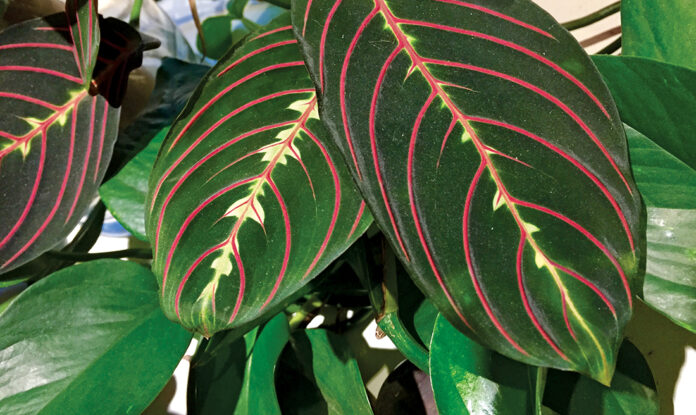Tucked on window sills and tabletops, my houseplants clean the air and provide indoor beauty while the landscape outdoors is mostly resting. They are easy to keep healthy if I follow a few tips during the dark days of winter. it’s their time to rest.
A typical houseplant lives in the understory of a tropical rain forest where it gets filtered light. They’re used to warm rain and perfect drainage. We put them in pots inside our homes where they have many different conditions to contend with. Most houseplants will tolerate darker conditions if you adjust your watering to accommodate the slower growth rate.
Water just enough to keep the soil from going dry allowing oxygen to move back into the root zone. Let the soil in a 4-6 inch pot dry half an inch down between waterings then water with room temperature water. Don’t let the pot sit in a saucer of water or the roots will rot. If your plant is in a larger pot let the soil dry a couple of inches between waterings. A moisture meter is very helpful for larger plants.
Move plants into the best light you have. Even a table lamp will provide light for a plant growing underneath. Remove dust with a moist cloth or place the entire plant under lukewarm water in the sink. Dust blocks light from reaching leaves.
Fertilize less often skipping December and January and starting up again with half-strength fertilizer in mid-February. Houseplants are essentially dormant in winter needing fertilizer only when active growth resumes.
Don’t repot a plant in winter when they are slow to grow new roots. Replant when the growing season resumes in March or April. Choose a pot only two inches bigger than the old pot each time you transplant. Most plants grow happily for years in the same pot and soil with proper fertilizing and watering during the growing season.
Avoid placing plants in cold drafts near high-traffic areas such as a foyer or hallway. Ficus trees are notorious for dropping leaves when exposed to temperature changes.
If you have medium to low light conditions in your house some of the best upright plants are philodendron, peace lily, Chinese evergreen, cast-iron plant, Schefflera, arboricola, ferns and palms. Hanging plants that grow well in low light are heart-shaped philodendron, pothos and grape ivy. Most of these houseplants grow naturally in low light areas of the jungle. Don’t overwater and they’ll be happy.
If you do find insects on your plants, a spray of mild insecticidal soap for houseplants usually does the trick if you do a follow-up spraying a week later. Horticultural oil works well, too, by smothering insects and their eggs. If you have tiny black fungus gnats flying over the soil you are watering too frequently. They feed on the algae growing on moist soil. Scrape off the surface, spray with insecticidal soap and let the soil dry out.
Jan Nelson, a landscape designer and California certified nursery professional, will answer questions about gardening in the Santa Cruz Mountains. Email her at ja******@*ol.com, or visit jannelsonlandscapedesign.com.









